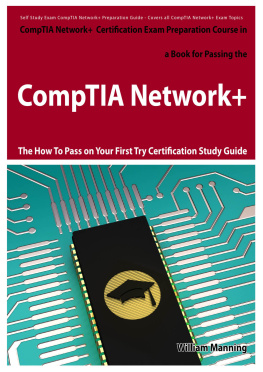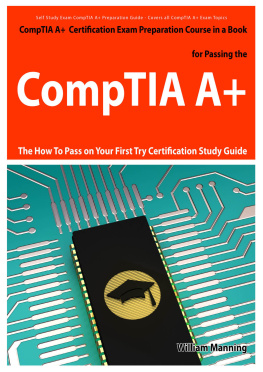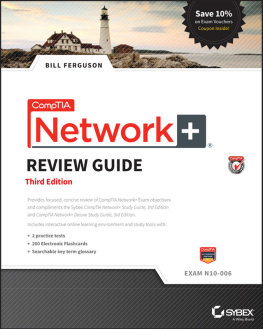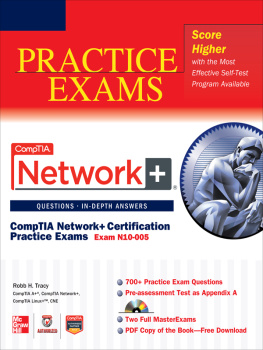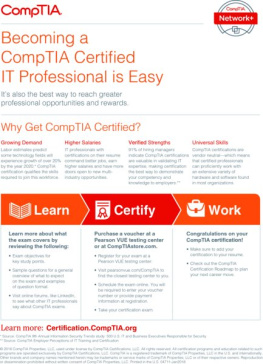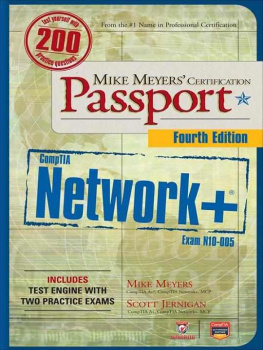William Manning - CompTIA Network+ Exam Preparation Course in a Book for Passing the CompTIA Network+ Certified Exam - The How To Pass on Your First Try Certification Study Guide
Here you can read online William Manning - CompTIA Network+ Exam Preparation Course in a Book for Passing the CompTIA Network+ Certified Exam - The How To Pass on Your First Try Certification Study Guide full text of the book (entire story) in english for free. Download pdf and epub, get meaning, cover and reviews about this ebook. year: 2012, publisher: Emereo Publishing, genre: Computer. Description of the work, (preface) as well as reviews are available. Best literature library LitArk.com created for fans of good reading and offers a wide selection of genres:
Romance novel
Science fiction
Adventure
Detective
Science
History
Home and family
Prose
Art
Politics
Computer
Non-fiction
Religion
Business
Children
Humor
Choose a favorite category and find really read worthwhile books. Enjoy immersion in the world of imagination, feel the emotions of the characters or learn something new for yourself, make an fascinating discovery.
- Book:CompTIA Network+ Exam Preparation Course in a Book for Passing the CompTIA Network+ Certified Exam - The How To Pass on Your First Try Certification Study Guide
- Author:
- Publisher:Emereo Publishing
- Genre:
- Year:2012
- Rating:3 / 5
- Favourites:Add to favourites
- Your mark:
- 60
- 1
- 2
- 3
- 4
- 5
CompTIA Network+ Exam Preparation Course in a Book for Passing the CompTIA Network+ Certified Exam - The How To Pass on Your First Try Certification Study Guide: summary, description and annotation
We offer to read an annotation, description, summary or preface (depends on what the author of the book "CompTIA Network+ Exam Preparation Course in a Book for Passing the CompTIA Network+ Certified Exam - The How To Pass on Your First Try Certification Study Guide" wrote himself). If you haven't found the necessary information about the book — write in the comments, we will try to find it.
William Manning: author's other books
Who wrote CompTIA Network+ Exam Preparation Course in a Book for Passing the CompTIA Network+ Certified Exam - The How To Pass on Your First Try Certification Study Guide? Find out the surname, the name of the author of the book and a list of all author's works by series.
CompTIA Network+ Exam Preparation Course in a Book for Passing the CompTIA Network+ Certified Exam - The How To Pass on Your First Try Certification Study Guide — read online for free the complete book (whole text) full work
Below is the text of the book, divided by pages. System saving the place of the last page read, allows you to conveniently read the book "CompTIA Network+ Exam Preparation Course in a Book for Passing the CompTIA Network+ Certified Exam - The How To Pass on Your First Try Certification Study Guide" online for free, without having to search again every time where you left off. Put a bookmark, and you can go to the page where you finished reading at any time.
Font size:
Interval:
Bookmark:
1 Foreword This Exam Preparation book is intended for those preparing for the CompTIA Network+certification with a broad networking focus. The Art of Service is an Accredited Training Organization for this program and has been training this course for more than 8 years. The strategies and content in this book are a result of experience and understanding of the Windows support disciplines, and the exam requirements. This book is a study aid to assist those who have completed an accredited course and are preparing for the exam. Do not underestimate the value of your own notes and study aids. The more you have, the more prepared you will be.
Due to licensing rights, we are unable to provide actual CompTIA Network+ Essentials Exams. However, the study notes and sample exam questions in this book will allow you to more easily prepare for the CompTIA Network+ Essentials exam. Ivanka Menken Executive Director The Art of Service Notice of Rights All rights reserved. No part of this book may be reproduced or transmitted in any form by any means, electronic, mechanical, photocopying, recording, or otherwise, without the prior written permission of the publisher. Notice of Liability The information in this book is distributed on an NAs IsO basis without warranty. While every precaution has been taken in the preparation of the book, neither the author nor the publisher shall have any liability to any person or entity with respect to any loss or damage caused or alleged to be caused directly or indirectly by the instructions contained in this book or by the products described in it.
Trademarks Many of the designations used by manufacturers and sellers to distinguish their products are claimed as trademarks. Where those designations appear in this book, and the publisher was aware of a trademark claim, the designations appear as requested by the owner of the trademark. All other product names and services identified throughout this book are used in editorial fashion only and for the benefit of such companies with no intention of infringement of the trademark. No such use, or the use of any trade name, is intended to convey endorsement or other affiliation with this book. Write a review to receive any free eBook from our Catalog - $99 Value! If you recently bought this book we would love to hear from you! Benefit from receiving a free eBook from our catalog at http://www.emereo.org/ if you write a review on Amazon (or the online store where you purchased this book) about your last purchase! How does it work? To post a review on Amazon, just log in to your account and click on the Create your own review button (under Customer Reviews) of the relevant product page. You can find examples of product reviews in Amazon.
If you purchased from another online store, simply follow their procedures. What happens when I submit my review? Once you have submitted your review, send us an email at review@emereo.org with the link to your review, and the eBook you would like as our thank you from http://www.emereo.org/. Pick any book you like from the catalog, up to $99 RRP. You will receive an email with your eBook as download link. It is that simple! 2 Table of Contents 1 FOREWORD ................................................................................................. 4 3 COMPTIA NETWORK+ CERTIFICATION ......................................................... 9 4 EXAM SPECIFICS ......................................................................................... 10 5 EXAM PREREQUISITES................................................................................ 10 6 NETWORK TECHNOLOGIES ......................................................................... 11 6.1 NETWORKING PROTOCOLS ................................................................................ 11 6.1.1 TCP/IP Suite ...................................................................................... 11 6.1.2 Transmission Control Protocol (TCP) ............................................... 12 6.1.3 File Transfer Protocol (FTP).............................................................. 12 6.1.4 Trivial File Transfer Protocol (TFTP) ................................................ 13 6.1.5 User Datagram Protocol (UDP) ....................................................... 14 6.1.6 Dynamic Host Configuration Protocol (DHCP) ................................ 14 6.1.7 Domain Name System (DNS) ........................................................... 15 6.1.8 Hypertext Transfer Protocol (HTTP) ................................................ 16 6.1.9 Hypertext Transfer Protocol Secure (HTTPS) ................................... 17 6.1.10 Transport Layer Security (TLS) .................................................... 17 6.1.11 Session Initiation Protocol (SIP) .................................................. 18 6.1.12 Real-Time Transport Protocol (RTP) ........................................... 18 6.1.13 Simple Mail Transport Protocol (SMTP) ..................................... 19 6.1.14 Post Office Protocol (POP3) ........................................................ 19 6.1.15 Internet Message Access Protocol (IMAP) ................................. 20 6.1.16 Telnet ........................................................................................... 20 6.1.17 Secure Shell (SSH) ........................................................................ 20 6.1.18 Simple Network Management Protocol (SNMP) ....................... 21 6.1.19 Network Time Protocol (NTP) ..................................................... 21 6.1.20 Internet Control Message Protocol (ICMP) ................................ 22 6.1.21 Internet Group Management Protocol (IGMP) ......................... 22 6.1.22 Address Resolution Protocol (ARP) ............................................. 22 6.2 DESIGNATED PORTS......................................................................................... 23 6.2.1 Common TCP Ports ........................................................................... 23 6.2.2 Common UDP Ports .......................................................................... 24 6.3 ADDRESS FORMATS ......................................................................................... 25 6.3.1 Internet Protocol (IP) ....................................................................... 25 6.3.2 IPv4 ................................................................................................... 25 6.3.3 IPv6 ................................................................................................... 27 6.3.4 MAC Address .................................................................................... 28 6.4 ADDRESSING TECHNOLOGIES ............................................................................. 29 6.4.1 Subnetting ........................................................................................ 29 6.4.2 Supernetting .................................................................................... 30 6.4.3 Public and Private Addresses ........................................................... 31 6.4.4 Network Access Translation ............................................................ 31 6.4.5 Port Address Translation (PAT) ....................................................... 32 6.4.6 Dynamic Host Configuration Protocol (DHCP) ................................ 32 6.5 ROUTING PROPERTIES ...................................................................................... 33 6.5.1 Interior versus Exterior Gateway Protocols .................................... 33 6.5.2 Static and Dynamic Routing ............................................................ 34 6.5.3 Network Hop .................................................................................... 35 6.5.4 Routing Tables ................................................................................. 35 6.5.5 Convergence ..................................................................................... 37 6.6 ROUTING PROTOCOLS ...................................................................................... 37 6.6.1 Distance Vector ................................................................................ 37 6.6.2 Link State .......................................................................................... 40 6.6.3 Hybrid ............................................................................................... 43 6.7 WIRELESS COMMUNICATION STANDARDS ............................................................ 43 6.7.1 IEEE 802.11 standards ...................................................................... 43 6.7.2 Authentication and Encryption ........................................................ 46 7 NETWORK MEDIA AND TOPOLOGIES ......................................................... 51 7.1 STANDARD CABLING ........................................................................................ 51 7.1.1 Unshielded Twisted Pair (UTP) ........................................................ 51 7.1.2 Shielded Twisted Pair (STP) ............................................................. 51 7.1.3 Coaxial Cables .................................................................................. 52 7.1.4 Optical Fiber ..................................................................................... 52 7.1.5 Serial Cables ..................................................................................... 52 7.1.6 Plenum Cable ................................................................................... 53 7.2 CONNECTOR TYPES .......................................................................................... 53 7.2.1 RJ-11 ................................................................................................. 53 7.2.2 RJ-45 ................................................................................................. 54 7.2.3 BNC ................................................................................................... 54 7.2.4 Subscriber Connector ....................................................................... 55 7.2.5 Straight Tip ....................................................................................... 55 7.2.6 Lucent Connector ............................................................................. 55 7.2.7 RS-232 .............................................................................................. 56 7.3 PHYSICAL NETWORK TOPOLOGIES ...................................................................... 56 7.3.1 Star ................................................................................................... 57 7.3.2 Mesh ................................................................................................. 57 7.3.3 Bus .................................................................................................... 58 7.3.4 Ring .................................................................................................. 58 7.3.5 Point-to-Point ................................................................................... 58 7.3.6 Hybrid ............................................................................................... 59 7.4 WIRING STANDARDS........................................................................................ 59 7.4.1 Straightforward and Crossover ....................................................... 59 7.4.2 Rollover ............................................................................................ 60 7.4.3 Loopback .......................................................................................... 60 7.5 WAN TECHNOLOGY TYPES ............................................................................... 60 7.5.1 WAN Properties ............................................................................... 60 7.5.2 Frame Relay ..................................................................................... 62 7.5.3 T-Carrier and E-Carrier ..................................................................... 63 7.5.4 Digital Subscriber Line ..................................................................... 64 7.5.5 Cable Modem ................................................................................... 65 7.5.6 Satellite ............................................................................................ 65 7.5.7 Wireless WAN .................................................................................. 65 7.5.8 Asynchronous Transfer Mode (ATM)............................................... 66 7.5.9 Synchronous Optical Networking (SONET)...................................... 66 7.5.10 Multiprotocol Label Switching (MPLS) ....................................... 67 7.5.11 Integrated Services Digital Network (ISDN) ............................... 68 7.5.12 Plain Old Telephone Service (POTS) ............................................ 70 7.5.13 Public Switched Telephone Network (PSTN) .............................. 70 7.6 LAN TECHNOLOGY TYPES ................................................................................. 70 7.6.1 LAN Properties ................................................................................. 70 7.6.2 Ethernet ............................................................................................ 71 7.7 LOGICAL NETWORK TOPOLOGIES ....................................................................... 74 7.7.1 Peer-To-Peer Networks .................................................................... 74 7.7.2 Server/Client Networks.................................................................... 74 7.7.3 Virtual Private Network (VPN) ........................................................ 75 7.7.4 Virtual LANs ..................................................................................... 76 7.8 WIRING DISTRIBUTION ..................................................................................... 77 7.8.1 Cross Connect Systems ..................................................................... 77 7.8.2 Patch Panels ..................................................................................... 77 7.8.3 66 Block ............................................................................................ 78 7.8.4 110 block .......................................................................................... 78 7.8.5 25 Pair .............................................................................................. 78 7.8.6 100 pair ............................................................................................ 79 7.8.7 Main Distribution Frame (MDF) ....................................................... 79 7.8.8 Intermediate Distribution Frame (IDF) ............................................. 79 7.8.9 Demarc ............................................................................................. 80 7.8.10 Smart Jack ................................................................................... 80 8 NETWORK DEVICES .................................................................................... 81 8.1 NETWORK DEVICES ......................................................................................... 81 8.1.1 Repeater ........................................................................................... 81 8.1.2 Hub ................................................................................................... 81 8.1.3 Modem ............................................................................................. 82 8.1.4 Network Interface Card ................................................................... 82 8.1.5 Media Converter .............................................................................. 83 8.1.6 Bridge ............................................................................................... 83 8.1.7 Switch ............................................................................................... 83 8.1.8 Wireless Access Point ....................................................................... 84 8.1.9 Router ............................................................................................... 87 8.1.10 Firewall ........................................................................................ 87 8.2 SPECIALIZED NETWORK DEVICES ........................................................................ 88 8.2.1 Multilayer Switch ............................................................................. 88 8.2.2 Intrusion Detection Systems ............................................................ 88 8.2.3 Load Balancer .................................................................................. 91 8.2.4 DNS Server ........................................................................................ 92 8.2.5 Traffic Shaper ................................................................................... 92 8.2.6 Proxy Server ..................................................................................... 93 8.2.7 Channel Service Unit (CSU)/ Data Service Unit (DSU) ..................... 94 8.3 SWITCH FEATURES .......................................................................................... 94 8.3.1 Power over Ethernet (PoE) Devices ................................................. 94 8.3.2 Spanning-Tree Protocol (STP) .......................................................... 97 8.3.3 Trunking ......................................................................................... 100 8.3.4 Port Mirroring ................................................................................ 101 8.3.5 Port Authentication ....................................................................... 101 8.4 BASIC WIRELESS NETWORK ............................................................................. 102 8.4.1 Clients ............................................................................................. 102 8.4.2 Using Access Points ........................................................................ 105 8.4.3 Wireless Troubleshooting .............................................................. 111 9 NETWORK MANAGEMENT ........................................................................117 9.1 OSI MODEL ................................................................................................. 117 9.2 CONFIGURATION MANAGEMENT DOCUMENTATION ............................................ 121 9.3 NETWORK EVALUATION ................................................................................. 122 9.4 NETWORK MONITORING ................................................................................ 123 9.5 NETWORK PERFORMANCE OPTIMIZATION.......................................................... 125 9.5.1 Quality of Service (QoS) ................................................................. 125 9.5.2 High Availability ............................................................................. 125 9.5.3 Fault Tolerance Systems ................................................................ 126 9.6 NETWORK TROUBLESHOOTING METHODOLOGY .................................................. 126 9.6.1 Connectivity Issues ......................................................................... 128 10 NETWORK TOOLS ......................................................................................129 10.1 COMMAND LINE INTERFACE TOOL ............................................................... 129 10.2 NETWORK SCANNING ................................................................................ 130 10.3 NETWORKING TOOLS ................................................................................ 132 11 NETWORK SECURITY .................................................................................133 11.1 USER AUTHENTICATION ............................................................................. 133 11.1.1 Public Key Infrastructure (PKI) .................................................. 133 11.1.2 Methodologies of Access Control ............................................. 133 11.1.3 One-Time Passwords ................................................................. 134 11.1.4 RADIUS ...................................................................................... 134 11.1.5 Single Sign On Implementations ............................................... 135 11.1.6 Kerberos .................................................................................... 135 11.2 SECURITY THREATS ................................................................................... 136 11.2.1 Denial of Service (DoS) .............................................................. 137 11.2.2 Buffer Overflows ....................................................................... 138 11.2.3 Mobile Code .............................................................................. 138 11.2.4 Malicious Software ................................................................... 139 11.2.5 Password Crackers .................................................................... 139 11.2.6 Spoofing/Masquerading ........................................................... 141 11.2.7 Sniffers, Eavesdropping, and Tapping ...................................... 142 11.2.8 Emanations................................................................................ 142 11.2.9 Shoulder Surfing ........................................................................ 143 11.2.10 Object Reuse .............................................................................. 143 11.2.11 Data Remanence ....................................................................... 144 11.2.12 Unauthorized Targeted Data Mining ....................................... 145 11.2.13 Dumpster Diving ....................................................................... 145 11.2.14 Backdoors and Trapdoors ......................................................... 146 11.2.15 Theft .......................................................................................... 146 11.2.16 Social Engineering ..................................................................... 146 12 ACRONYMS ...............................................................................................148 13 PRACTICE EXAM ........................................................................................161 13.1 REFRESHER QUESTIONS ............................................................................. 161 14 ANSWER GUIDE ........................................................................................174 14.1 ANSWERS TO QUESTIONS .......................................................................... 174 15 REFERENCES ..............................................................................................180 16 INDEX .......................................................................................................181 3 CompTIA Network+ Certification The CompTIA Network+ certification is an internationally recognized, vendor neutral certification for network practitioners. 174 15 REFERENCES ..............................................................................................180 16 INDEX .......................................................................................................181 3 CompTIA Network+ Certification The CompTIA Network+ certification is an internationally recognized, vendor neutral certification for network practitioners.
Next pageFont size:
Interval:
Bookmark:
Similar books «CompTIA Network+ Exam Preparation Course in a Book for Passing the CompTIA Network+ Certified Exam - The How To Pass on Your First Try Certification Study Guide»
Look at similar books to CompTIA Network+ Exam Preparation Course in a Book for Passing the CompTIA Network+ Certified Exam - The How To Pass on Your First Try Certification Study Guide. We have selected literature similar in name and meaning in the hope of providing readers with more options to find new, interesting, not yet read works.
Discussion, reviews of the book CompTIA Network+ Exam Preparation Course in a Book for Passing the CompTIA Network+ Certified Exam - The How To Pass on Your First Try Certification Study Guide and just readers' own opinions. Leave your comments, write what you think about the work, its meaning or the main characters. Specify what exactly you liked and what you didn't like, and why you think so.

